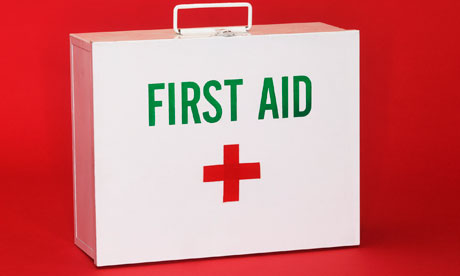
Time for a little safety announcement. Inevitably you are cleaning your house, finishing some project, or fixing something that broke in your home. And all of a sudden you actually cut yourself, trip on something, or just plain bang into something. Injuries happen around the home. But what do you need to do taking care of yourself with good first aid practices.
First of all, if you are seriously injured with deep cuts, falls, or what you suspect is a broken bone or muscle injury, see a physician or make a trip to the emergency room for the proper care.
For minor injuries around the home, keep a first aid kit on hand. According to the Red Cross,
a standard first aid kit for the home consists of:
- -2 absorbent compress dressings (5 x 9 inches)
- -25 adhesive bandages (assorted sizes)
- -5 antiseptic wipe packets
- -1 adhesive cloth tape (10 yards x 1 inch)
- -5 antibiotic ointment packets (approximately 1 gram)
- -2 packets of aspirin (81 mg each)
- -1 breathing barrier (with one-way valve)
- -2 pair of nonlatex gloves (size: large)
- -1 roller bandage (3 inches wide)
- -2 hydrocortisone ointment packets (approximately 1 gram each)
- -Scissors
- -1 roller bandage (4 inches wide)
- -5 sterile gauze pads (3 x 3 inches)
- -1 instant cold compress
- -5 sterile gauze pads (4 x 4 inches)
- -Oral thermometer (non-mercury/nonglass)
- -2 triangular bandages
- -Tweezers
- -First aid instruction booklet
- -1 blanket (space blanket)
Also, you can buy these kits configured in your local stores or order one from the Red Cross.
In addition to general bandages and ointments on hand. It is also good time to know where your needed medications are and having flashlights accessible should any power outage occur.
A friendly reminder to stay safe during those home projects.

